Sponsored article
Summer is the period of increased activity of ticks, which invariably for years have been transmitting dangerous diseases. Unfortunately, the most vulnerable to their attack are domestic and free-living pets. When warm spring and summer days arrive, you can be sure that ticks are lurking in some corner of your garden, so it is necessary to protect your pets from their invasion. See what measures you can take to protect your pets from ticks
Both dogs and cats are at high risk of tick-borne diseases. All of them are dangerous and can lead to long, expensive and difficult treatment or even death for your pet if you react to the symptoms too late
Babesiosis is the disease that furries most often contract after a close encounter with a tick. It manifests itself primarily by apathy and a lack of appetite, to which neurological disorders such as sudden loss of balance or catching the invisible fly (snapping its snout, jumping, waving its paws) often appear. Later stages include vomiting and diarrhea with blood and hematuria, shortness of breath, heart palpitations, and elevated body temperature. Babesiosis can have very serious health consequences, especially for the nervous system. One of the most serious complications after babesiosis, which occurs mainly in dogs, is idiopathic epilepsy

Anaplasmosis has a similar course to babesiosis, but nosebleeds, lameness and muscle aches should be added to the symptoms. This disease is less dangerous than its predecessor, but it can have a negative impact on, for example, the work of the pancreas, so your pet can develop diabetes. It can also cause serious anemia that requires long treatment. Anaplasmosis can be asymptomatic or very mild, which doesn’t mean that it doesn’t require vet intervention.
Erlichiosis is a disease that mainly affects dogs. Its symptoms can appear even up to 11 days after a tick bite, so after finding a small intruder in your dog’s skin you still have to observe him. It is a chronic disease, which can be asymptomatic for many years. It becomes a problem only when the dog’s immune system is weakened, for example during an infection. Then the ehrlichiosis makes the disease run much more severely and the caregivers often find out about the presence of ehrlichia by accident. These bacteria attack the liver and spleen, making it difficult to metabolize drugs. This is why ehrlichiosis can seriously complicate the treatment of many diseases
Tick-borne diseases can be insanely dangerous for pets, so prevention is essential. Invasion of parasites, not just ticks, can lead to diseases that are difficult to treat. There are many products on the market to repel ticks and other insects from pets, so that furries are safe. A tick product for your cat or dog needs to be effective first and foremost. Whether you choose a collar, drops, spray or tablets, it is important that the method of prevention you choose is safe and works. It is good to consult such a choice with your veterinarian, because many antiparasitic products can interact with the medications your pet is taking or affect the course of diseases
Every pet owner has a responsibility to protect their pets from the suffering that tick-borne diseases bring. If you have outdoor cats, be sure to protect them from ticks. While a non-outdoor cat does not need such protection, it is a must for a dog, as the four-legged creature will bushwhack through tall grasses and bushes several times a day during walks